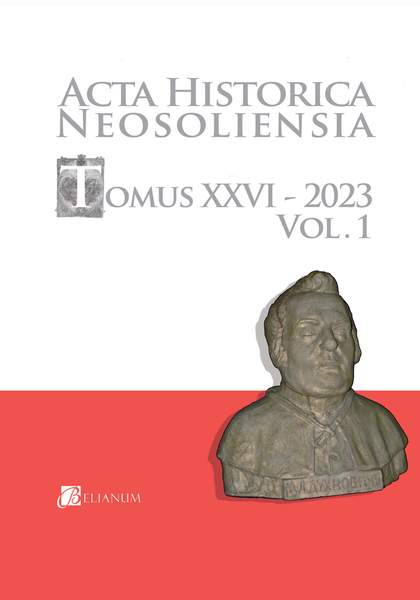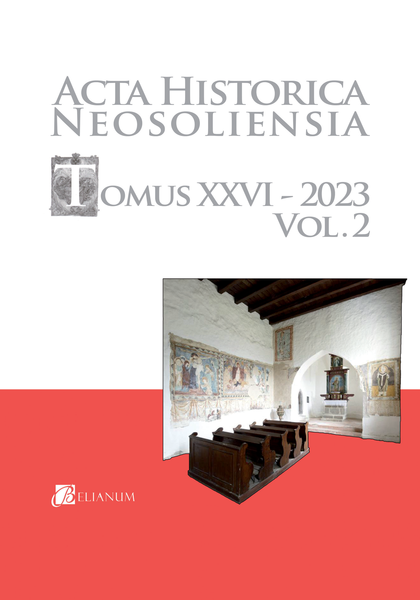Vnútorné členenie a príslušenstvá šľachtickej kúrie na konci stredoveku (deľba kúrie v Lukavici v roku 1524)
PAVOL MALINIAK
Katedra histórie, Filozofická fakulta, Univerzita Mateja Bela
v Banskej Bystrici
Interior arrangement and accessories of a manor house at the end of the Middle Ages (division of the manor in Lukavica in 1524)
Abstract: In 1524 brothers John, George and Stephen divided the manor house (curia nobilitaris) of their father in the village Lukavica into three parts. Only the first of the brothers remained living in Lukavica and was still a lower-ranking member of the nobility. The division of the manor describes the interior spaces of the house: the black room, the old kitchen, the room behind the kitchen, the hall and the room with lighting. The house also had a cellar. In the courtyard there was a piggery, stables, barn and a chicken coop. The entrance consisted of a gate with a small tower. Another black room, a brewery, a pond and a mill belonged to the nobleman’s house. The division is exceptionally detailed and it is a unique source in the region of the Zvolen County. The charter has been preserved in a copy from the middle of the 16th century. The manor and its accessories became the subject of disputes and repeated divisions over the following generations. Female members of the family, in some cases married to non-nobles, played an important role in these disputes. The manor house in Lukavica still existed at the end of the 17th century after the change of owners. It is possible that it was subsequently converted into a farmstead, which still exists to the north of the village.
Keywords: manor house, lower nobility, female inheritance, Lukavica village, Zvolen County.
Archív
Úplné textové verzie vo formáte PDF
- Acta historica Neosoliensia - Tomus 26, num. 1
- Acta historica Neosoliensia - Tomus 25, num. 2
- Acta historica Neosoliensia - Tomus 25, num. 1
- Acta historica Neosoliensia - Tomus 24, num. 2
- Acta historica Neosoliensia - Tomus 24, num. 1
- Acta historica Neosoliensia - Tomus 23, num. 2
- Acta historica Neosoliensia - Tomus 23, num. 1
- Acta historica Neosoliensia - Tomus 22, num. 2
- Acta historica Neosoliensia - Tomus 22, num. 1
- Acta historica Neosoliensia - Tomus 21, num. 2
- Acta historica Neosoliensia - Tomus 21, num. 1
- Acta historica Neosoliensia - Tomus 20, num. 2
- Acta historica Neosoliensia - Tomus 20, num. 1
- Acta historica Neosoliensia - Tomus 19, num. 2
- Acta historica Neosoliensia - Tomus 19, num. 1
- Acta historica Neosoliensia - Tomus 18
- Acta historica Neosoliensia - Tomus 17
- Acta historica Neosoliensia - Tomus 16
- Acta historica Neosoliensia - Tomus 15
- Acta historica Neosoliensia - Tomus 14
- Acta historica Neosoliensia - Tomus 13
- Acta historica Neosoliensia - Tomus 12
- Acta historica Neosoliensia - Tomus 11
- Acta historica Neosoliensia - Tomus 10
- Acta historica Neosoliensia - Tomus 09
- Acta historica Neosoliensia - Tomus 08
- Acta historica Neosoliensia - Tomus 07
- Acta historica Neosoliensia - Tomus 06
- Acta historica Neosoliensia - Tomus 05
- Acta historica Neosoliensia - Tomus 04
- Acta historica Neosoliensia - Tomus 03
- Acta historica Neosoliensia - Tomus 02
- Acta historica Neosoliensia - Tomus 01

Interetnické vzťahy v prostredí Rusínov a Slovákov (na Slovensku a na Dolnej zemi) v 19. storočí1
MICHAL ŠMIGEĽ – MIROSLAV KMEŤ
Katedra histórie, Filozofická fakulta, Univerzita Mateja Bela v Banskej Bystrici
Inter ethnic relations in the environment of Rusyns and Slovaks (in Slovakia and the Lowland) in the 19th century
Abstract: Rusyns and Slovaks, members of two culturally close ethnic groups, had lived for centuries in one state unit and in immediate neighbour contact. Complex socio-economic situation of the Rusyn settlement area in Slovakia had conditioned the poor development of both cultural and national needs. Rusyn intelligentsia from Greek-Catholic church circles had tended towards Hungarian culture or a broader Slavic consciousness. From the beginning of the 19th century and during the spread of pan-Slavism with the development of national movements and the formation of modern nations, Rusyns became the object of interest in Slovak intellectual circles. The Rusyn elite, inspired by Slavic and non-Slavic national movements, revived nationally in the revolutionary period of the 1840s. It was also the merit of Slovaks who supported the national awakening of Rusyns as their closest allies in the Kingdom of Hungary during the peak period of the Slovak national revival movement (1836–1848). The mutuality of Rusyn-Slovak political cooperation had been manifested in the revolutionary years of 1948–1949 in the Habsburg Monarchy. Even though the revolution in the Kingdom of Hungary had failed, it had brought some significant changes in the sphere of social development, civil principles and the weakening of the influence of the state and the church. These new conditions had enabled the emergence and development of Rusyn national revival movement and the so-calledrevivalistic generation of Rusyns. Mutual contacts between the two national movements, especially in the post-revolutionary period, had symbolized social, political and literary activities of several nationalities. Even in the second half of the 19th century, Slovak elites had a positive influence on the development of the Rusyn national movement. Slovak environment had an inspiring effect on Rusyns. Of course, this relationship had not only worked from the side of Slovaks to Rusyns, but also in the opposite direction (in a lesser extent), i.e. from Rusyns to Slovaks. Finally, during the period of dualism (1867–1918), the reflection of Rusyn issue in Slovak literature was not as intense as before the revolution, which was related to strong national oppression of minorities by the Hungarian governments. The national movements of Rusyns and Slovaks had to cope with a very complicated political and social reality, so there was much less scope for wider cooperation and mutual reflection than before. Complex socio-economic situation of northern and northeastern Kingdom of Hungary at the end of the 19th century together with the rapidly increasing Slovak and Rusyn emigration had a significant influence on this.
Keywords: Rusyns and Slovaks in the 19th century, ethno-identification and nation-forming processes, Rusyn national movement, Slovak and Rusyn national revival movement, Štúr generation, Rusyn revivalistic generation, the revolution in Hungary (1848–1849).
1 Štúdia je výstupom z grantovej úlohy VEGA č. 1/0426/20 „Slovenské dolnozemské komunity v reflexii materskej krajiny počas medzivojnovej Československej republiky“.

